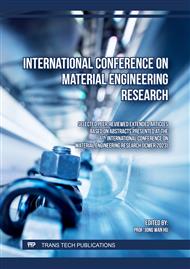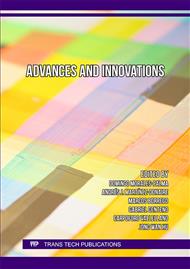[1]
Y. Zhang, H. Li, S. Huang, S. Fan, L. Sun, B. Tian, F. Chen, Y. Wang, Y. Shi, and H.Y. Yang, Rechargeable Aqueous Zinc-Ion Batteries in MgSO4/ZnSO4 Hybrid Electrolytes, Nanomicro Lett. 2020, 12, 60-60.
DOI: 10.1007/s40820-020-0385-7
Google Scholar
[2]
C.-M. Yang, and B.-H. Kim, Highly conductive pitch-based carbon nanofiber/MnO2 composites for high-capacitance supercapacitors, J. Alloy. Comp. 2018, 749, 441-447
DOI: 10.1016/j.jallcom.2018.03.305
Google Scholar
[3]
K. D. Behler, A. Stravato, V. Mochalin, G. Korneva, G. Yushin and Y. Gogotsi, Nanodiamond-Polymer Composite Fibers and Coatings, ACS Nano, 2009, 3, 363–369.
DOI: 10.1021/nn800445z
Google Scholar
[4]
X. Lu, C. Wang, F. Favier, and N. Pinna, Electrospun Nanomaterials for Supercapacitor Electrodes: Designed Architectures and Electrochemical Performance, Adv. Energy Mater. 2016, 7, 1601301.
DOI: 10.1002/aenm.201601301
Google Scholar
[5]
N. Diez, P. Díaz, P. Álvarez, Z. González, M. Granda, C. Blanco, R. Santamaría, and R. Menéndez, activated carbon fibers prepared directly from stabilized fibers for use as electrodes in supercapacitors, Mat. Lett. 2014, 136, 214–217.
DOI: 10.1016/j.matlet.2014.08.017
Google Scholar
[6]
X. Xu, Li Yang, W. Zheng, H. Zhang, F. Wu, Z. Tian, P. Zhang, and Z. Sun, MXenes with applications in supercapacitors and secondary batteries: A comprehensive review, Mat. Rep.: Energy, 2022, 2
DOI: 10.1016/j.matre.2022.100080
Google Scholar
[7]
X. Zhang, Z. Zhang, and Z. Zhou, MXene-based materials for electrochemical energy storage, J. Energy Chem., 2018, 27, 73–85.
Google Scholar
[8]
J. Zhang, S. Seyedin, Z. Gu, W. Yang, X. Wanga, and J. M. Razal, MXene: a potential candidate for yarn supercapacitors, Nanoscale, 2017, 9, 18604–18608.
DOI: 10.1039/c7nr06619h
Google Scholar
[9]
A. S. Levitt, M. Alhabeb, C. B. Hatter, A. Sarycheva, G. Dionb, and Y. Gogotsi, Electrospun MXene/carbon nanofibers as supercapacitor electrodes, J. Mat. Chem. A, 2019, 7, 269–277.
DOI: 10.1039/c8ta09810g
Google Scholar
[10]
A. C. Ferrari and J. Robertson, Resonant Raman spectroscopy of disordered, amorphous, and diamondlike carbon, Phys Rev. B, 2001, 64, 75414-75427.
DOI: 10.1103/physrevb.64.075414
Google Scholar
[11]
K. Allen-Perry, W. Straka, D. Keith, Sh. Han, L. Reynolds, Bh. Gautam, and D. E. Autrey, Tuning the Magnetic Properties of Two-Dimensional MXenes by Chemical Etching, Materials, 2021, 14, 694-713.
DOI: 10.3390/ma14030694
Google Scholar
[12]
P. Pattananuwata, D. Aht-ong, Controllable morphology of polypyrrole wrapped graphene hydrogel framework composites via cyclic voltammetry with aiding of poly (sodium 4-styrene sulfonate) for the flexible supercapacitor electrode, Electrochim. Acta, 2017, 224, 149–160.
DOI: 10.1016/j.electacta.2016.12.036
Google Scholar



